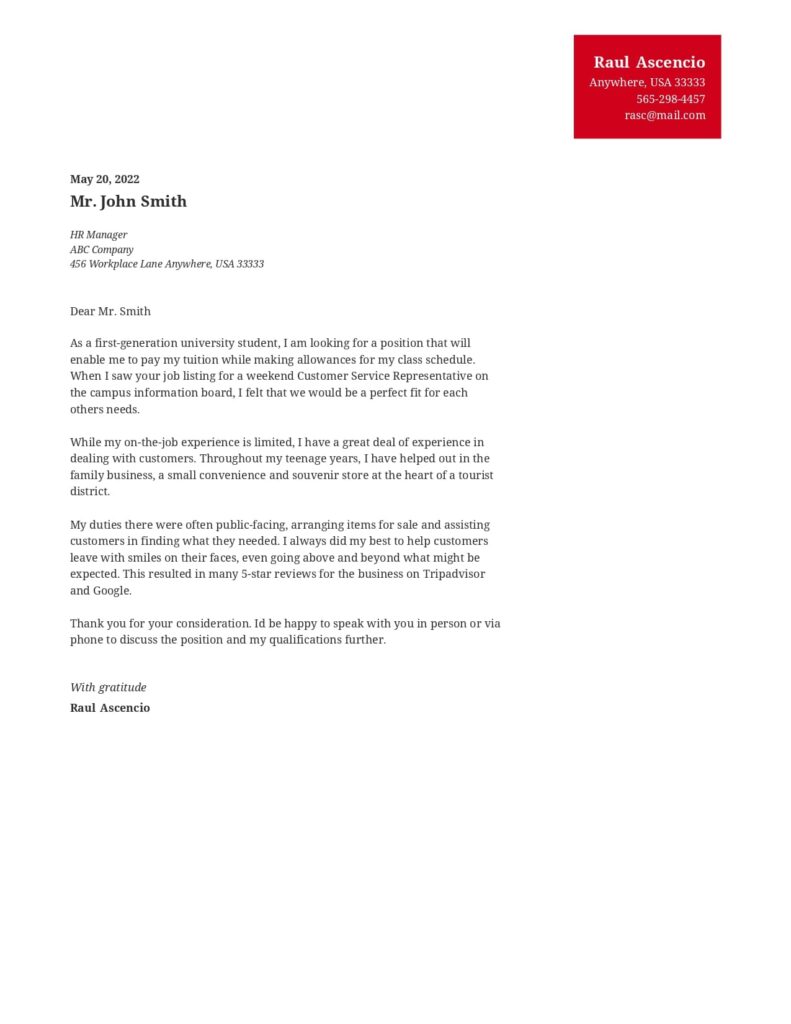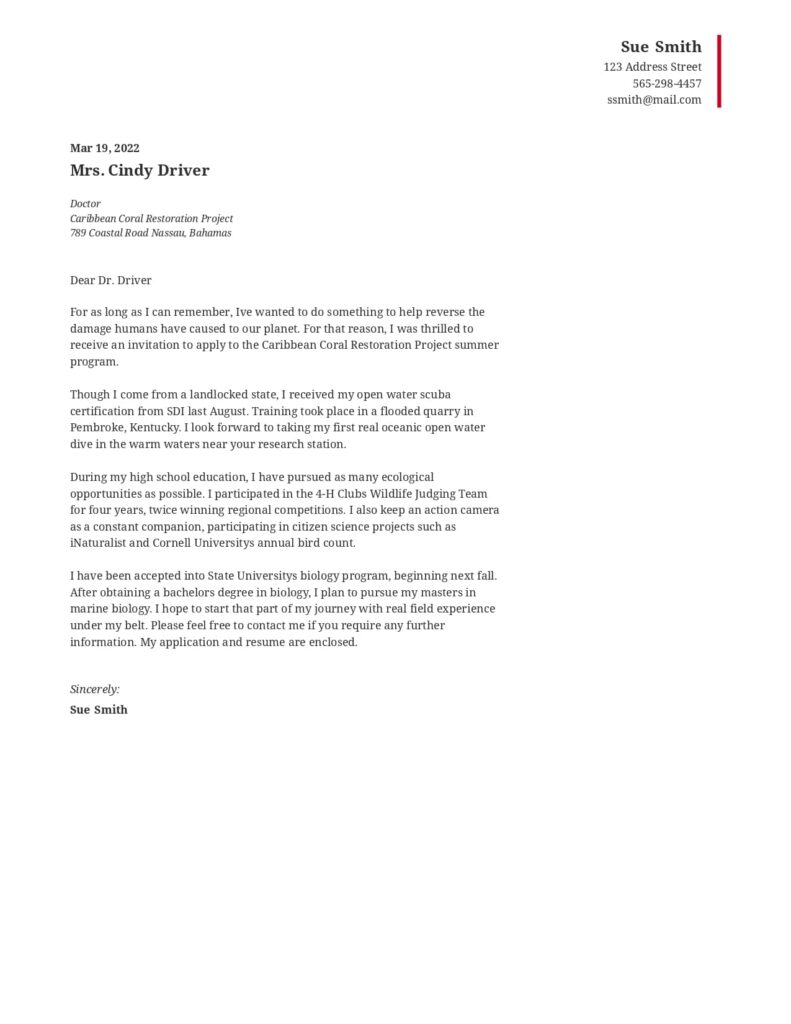What is a motivation letter? Perhaps you have never used this increasingly popular job acquisition tool.
Below, we will examine what a motivation letter is, when you should use one, and how to write it. We will also share some examples to inspire you.
What Is a Motivation Letter?
A motivation letter or letter explaining why you are the perfect candidate for the job. It is short, only one page in length. It contains examples of your achievements and interests.
Usually, motivation letters are attached to your resume when you are applying for a job. They can also be used in non-employment situations, such as when you apply to a college or university, an educational program, an internship, or a volunteer role.
“But, wait a second,” you may be thinking. “Isn’t that what a cover letter is for?” There are similarities and differences between these two documents. We will discuss them below.
Motivation Letter vs. Cover Letter
At first glance, a cover letter and a letter of motivation might appear to be the same thing. They are each one page or less in length, and they accompany your resume and/or application. The intent of both types of letters is to convince the hiring manager to consider your application further.
There is one big difference between these two types of letters, however.
Cover letters provide specific examples of how your education, skills, job experience, and achievements match the requirements for the job at hand. Cover letters focus on your work experience.
Motivation letters, on the other hand, are broader in scope. Rather than specifics, motivation letters exemplify your interests, personality traits, and your motives for applying.
That means that they are perfect for when you have little or no relevant experience. We’ll examine this further in the next section.
When to Use a Motivation Letter
As mentioned above, motivation letters can be used instead of cover letters when you have little or no experience relevant to the position for which you are applying. That means that this type of letter is especially useful in specific circumstances, like for entry-level positions.
1. Motivation Letter for University
Your passion and enthusiasm for a university or course of study may not come across in your application alone. Use your letter to highlight things like your family’s history with the university, why you’ve always wanted to attend that specific school, or why you are a good fit for one of their programs.
2. Motivation Letter for Job
When you are seeking your first entry-level job, you may not yet have any work experience to include on your resume. But you may have qualities and enthusiasm that set you apart as a good fit.
3. Other Times to Use Motivation Letters
You can also use these types of letters to explain why you are an ideal candidate for positions that don’t have anything to do with education or employment.
For example, a motivational letter for a volunteer position or an internship would give your application a huge boost.
How to Format a Motivation Letter
The motivation letter structure is crucial for presenting your ideas and desire to make an impact in a new company. In this section, we will delve into the key parts of a motivation letter, including the introduction, body, and conclusion.
We will also provide guidance on what to include in each section to create a compelling and well-formed letter.
Introduction and Recipient Information
Your motivation letter format should start with a professional salutation, addressing the recipient by name and title if possible.
If you are unsure of the recipient’s name, use a general salutation such as “Dear Sir/Madam” or “To Whom It May Concern.” The introduction should then briefly introduce yourself and state the purpose of the letter, e.g., applying for a job, internship, or scholarship.
Body
The body of the letter is where you should explain your motivation and qualifications for the opportunity you are seeking. Divide the body into two or three paragraphs for clarity and ease of reading.
- Motivation: In the first paragraph, discuss your motivation for applying. Explain why you are passionate about the opportunity, what attracts you to the organization, and how the experience aligns with your career goals.
- Qualifications: In the next paragraph(s), highlight your qualifications and relevant experiences. Draw attention to specific skills, achievements, or knowledge that make you a strong candidate. Use concrete examples to demonstrate your capabilities and show how they relate to the requirements of the position or opportunity.
Conclusion
By adding the correct ending you can complete your motivation letter layout by summarizing your main points and expressing enthusiasm for the opportunity.
Offer your availability for an interview or further discussion and provide your contact information. Finally, end with a professional closing, such as “Sincerely” or “Best regards,” followed by your full name.
By paying close attention to the format and structure, you can create a compelling and well-organized document that effectively showcases your motivation, qualifications, and enthusiasm for the opportunity.
How to Write a Motivation Letter
If you find resume and cover letter writing, a challenge, you might feel that motivation letters are intimidating as well. The good news is, they don’t have to be!
Create a Motivation Letter Template
Now that you understand exactly how the motivation letter layout should be it’s time to dive between the lines.
To know exactly how to write a motivation letter for a job application it’s really important to include all the necessary details.
Like a typical business letter, a motivational letter requires maintaining a professional tone and adhering to standard business letter formatting. Use the steps below to develop your text to show exactly why you are the perfect candidate for any position you’re interested in.
- Download a template: To make the job easier, using a motivation letter template will help you avoid going over the top when discussing your motivation and ensure you don’t leave anything out.
- Include your address: Include your address either as part of the letterhead at the top of the page or one line above the date. Your name is not necessary in this section, only your street address, city, state, and zip code.
- Write the Date: Include the date in a full format, such as “April 6, 2023.”
Specify the recipient’s address: Provide the title, name, and mailing address of the individual you are addressing the letter to, properly formatted with the recipient’s street address, city, state, and zip code. - Make your salutation: Open your letter with a polite greeting, typically using “Dear” followed by the recipient’s full name or title and last name (e.g., “Dear Mr. Smith” or “Dear Dr. Johnson”). End the salutation with a colon.
- Develop the body: Divide the body of your letter into concise paragraphs. Start by stating the position or program you are interested in, then explain your motivations and desires for pursuing it. Highlight your qualifications, skills, and relevant experiences that make you an ideal candidate. Be specific and provide examples or anecdotes that support your claims.
- Close your letter: Conclude your letter with a courteous closing phrase, such as “Sincerely,” “Thank you,” or “With gratitude,” followed by a colon. This demonstrates your appreciation for the recipient’s time and consideration.
- Add your signature: If sending a hard copy, leave at least four line spaces for signing your name by hand. This space is not necessary for an email or electronic copy of the letter.
It’s also a good idea to type your full name, regardless of whether you are sending a physical or electronic copy. This serves as your identifier and implies your agreement with the contents of the letter.
If you decide to send anything along with your letter, indicate and identify them by including “Enclosures: Resume, Completed Application,” or similar phrasing in your letter.
In an email, simply mention any attachments within the letter body or in a separate line below your typed name.
Motivation Letter Writing Tips
You can use the following tips as a checklist to make sure your letter is the best it can be.
-
- Use the hiring manager’s name if possible. It is always best to address the hiring manager or point of contact by name. If you don’t know their name, do your research – check the organization’s website or give them a call. You can use their full name (i.e., Chris Smith) or their title and last name (Dr. Smith). If you are unsure of the recipient’s gender or preferred pronouns, use gender-neutral titles (such as their job title) or the first and last name sans the title.
- Don’t rehash your resume. Rather than repeating yourself, use the letter to include things that didn’t fit your resume.
- Use action verbs to breathe life into your letter.
- Include resume keywords. The company might pass both your resume and letter through an applicant tracking system (ATS).
- Don’t beg. You want to make it known that you want the position, but you don’t want to sound desperate.
- Don’t lie. Eventually a hiring manager will find out if you’ve exaggerated or made up something in your letter.
- In the closing paragraph, include why you would be a good fit for the position, what you would like to learn, and what you hope to gain from the experience. Then, include a call to action, such as “Please feel free to contact me if you require further details,” or “I look forward to interviewing with you soon.”
- Proofread your letter. Nothing hurts your professionalism faster than typos or other errors. Use a proofreading program like Grammarly to check for mistakes you might have missed.
Motivation Letter Sample
Because motivation letters are used in such a wide variety of circumstances, their content will necessarily vary. You can tailor the format and content of the following example to fit your unique needs.
The following motivation letter example concerns an entry-level job. Raul has not yet held any paid positions, but he highlights the relevant experience that might not be evident on his resume.

Text Format:
123 Address Street
Anywhere, USA 33333
September 10, 2022
John Smith
HR Manager
ABC Company
456 Workplace Lane
Anywhere, USA 33333
Dear Mr. Smith:
As a first-generation university student, I am looking for a position that will enable me to pay my tuition while making allowances for my class schedule. When I saw your job listing for a weekend Customer Service Representative on the campus information board, I felt that we would be a perfect fit for each other’s needs.
While my on-the-job experience is limited, I have a great deal of experience in dealing with customers. Throughout my teenage years, I have helped out in the family business, a small convenience and souvenir store at the heart of a tourist district.
My duties there were often public-facing, arranging items for sale and assisting customers in finding what they needed. I always did my best to help customers leave with smiles on their faces, even going above and beyond what might be expected. This resulted in many 5-star reviews for the business on Tripadvisor and Google.
Thank you for your consideration. I’d be happy to speak with you in person or via phone to discuss the position and my qualifications further.
With gratitude:
Raul Ascencio
The following motivation letter example concerns an academic program. Sue is a high school senior seeking a summer internship after graduation. Her letter is imbued with a passion for the field as well as its relationship to her career goals.

Text Format:
123 Address Street
Anywhere, USA 33333
March 1, 2023
Cindy Diver
Caribbean Coral Restoration Project
789 Coastal Road
Nassau, Bahamas
Dear Dr. Diver,
For as long as I can remember, I’ve wanted to do something to help reverse the damage humans have caused to our planet. For that reason, I was thrilled to receive an invitation to apply to the Caribbean Coral Restoration Project summer program.
Though I come from a landlocked state, I received my open water scuba certification from SDI last August. Training took place in a flooded quarry in Pembroke, Kentucky. I look forward to taking my first “real” oceanic open water dive in the warm waters near your research station.
During my high school education, I have pursued as many ecological opportunities as possible. I participated in the 4-H Club’s Wildlife Judging Team for four years, twice winning regional competitions. I also keep an action camera as a constant companion, participating in citizen science projects such as iNaturalist and Cornell University’s annual bird count.
I have been accepted into State University’s biology program, beginning next fall. After obtaining a bachelor’s degree in biology, I plan to pursue my master’s in marine biology. I hope to start that part of my journey with real field experience under my belt. Please feel free to contact me if you require any further information. My application and resume are enclosed.
Sincerely:
Sue Smith
Key Takeaways
With the correct format and style you can create a motivation letter that can win over any recruiter. To do so remember the key points that were addressed in this guide.
- Motivation letters can effectively be used in place of cover letters when you have little experience or are applying to a university, internship, or volunteer program.
- Use professional business letter formats.
- Address your motivations and qualifications clearly in the body of your letter.
- Express your personality, passions, and motivations.
Ensuring your letter is written in this style will boost your chances whether you’re an entry level employee or an experienced worker.




